Best Solar Cable Ties for Outdoor Applications: A Comprehensive Guide
August 1, 2025

How can you ensure that your solar installations stay secure and efficient, no matter the weather? Durability is key when it comes to solar systems, especially when the wiring is exposed to harsh outdoor conditions. The cables and wires that connect your solar panels must remain firmly in place, unaffected by UV rays, extreme temperatures, and environmental wear.
This is where cable ties come in. Known for their strength and resistance to the elements, cable ties are the ideal solution for securing cables in solar power systems. But with various types available, it’s important to select one that suits your specific needs, ensuring maximum durability and system reliability over time.
In this blog, we’ll dive into everything you need to know about cable ties for solar installations. From understanding their key features to exploring their best uses and how to choose the right one for your project, we’ll guide you through every aspect of securing your solar wiring with confidence.
What Are Cable Ties and Why Are They Important?
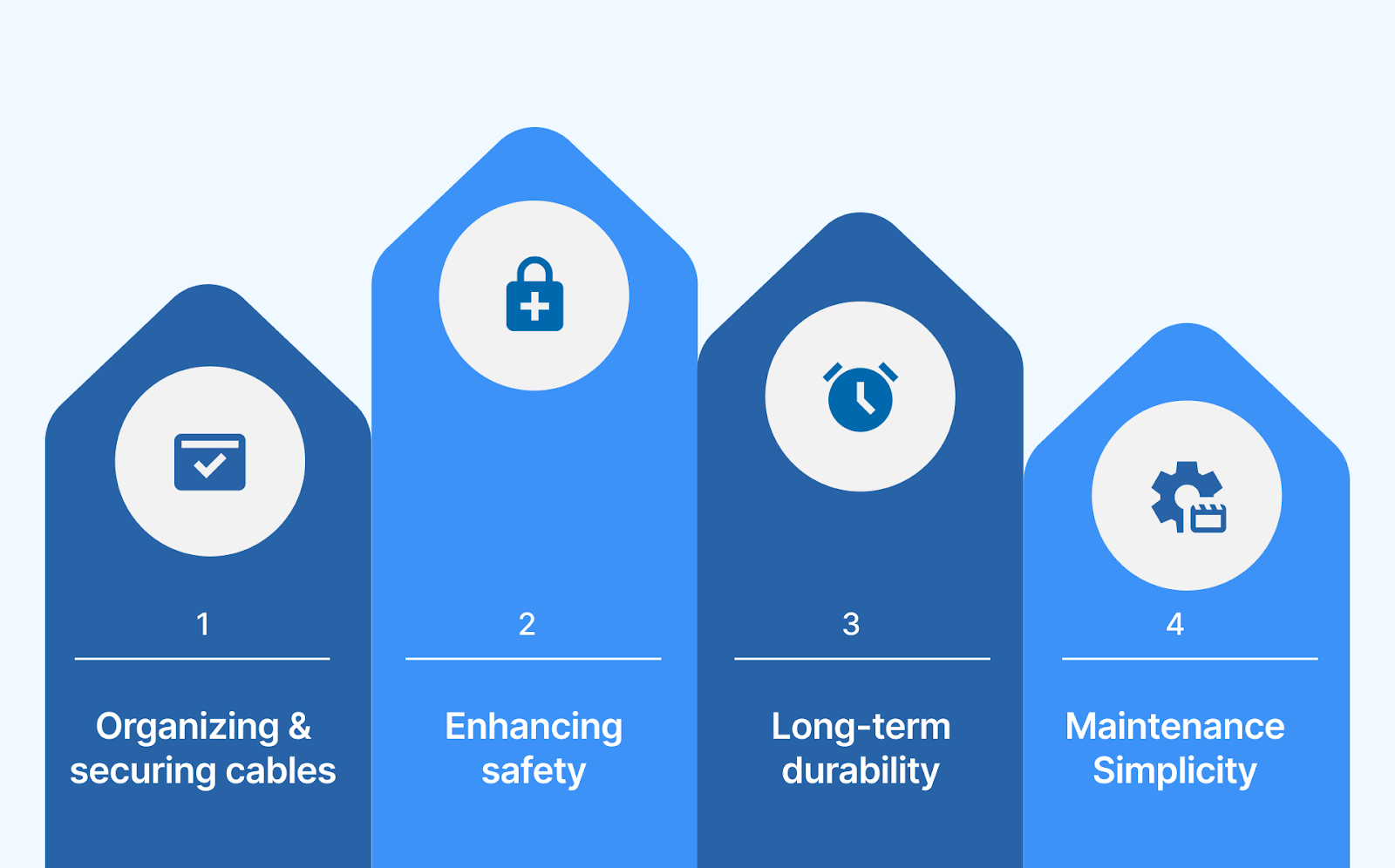
Cable ties are simple yet versatile fastening tools used to secure, bundle, and organize cables and wires. Typically made of durable materials such as nylon or stainless steel, these small components serve an essential role in countless industries, from automotive and aviation to renewable energy systems like solar and wind installations.
By keeping cables neatly arranged, cable ties prevent tangling, reduce wear and tear, and simplify troubleshooting or modifying wiring systems when necessary. Their importance cannot be overstated, especially in demanding environments like solar panel installations. Here’s why cable ties are indispensable:
- Organizing and securing cables: Cable ties help bundle multiple wires together, keeping them neatly arranged and minimizing the risk of tripping or snagging.
- Enhancing safety: Cable ties reduce the chances of electrical faults by preventing loose cables from coming into contact with moving parts or becoming a fire hazard.
- Long-term durability: High-quality cable ties, like stainless steel varieties, offer the strength and resistance necessary to withstand the harshest conditions, ensuring that the system remains intact and efficient over time.
- Ease of maintenance and adjustments: Cable ties make it easy to manage and adjust wiring setups, ensuring that maintenance tasks are carried out swiftly and efficiently without damaging the cables or the system.
Now that we have explored the importance of cable ties, next we’ll explore the unique demand and challenges of solar installation.
Meeting the Unique Demands of Solar Installations
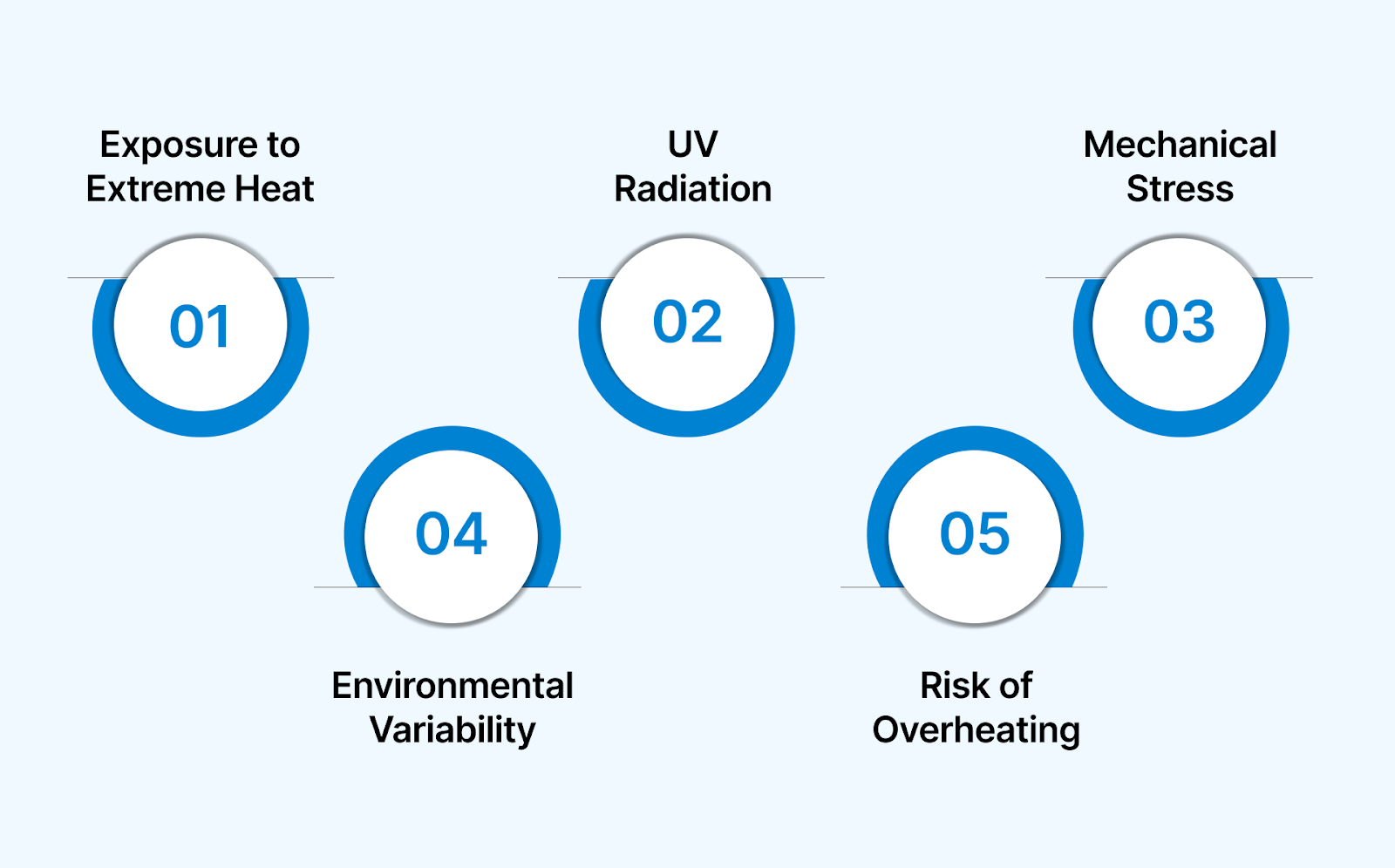
Solar installations operate in some of the most demanding environments, exposed to constant heat, sunlight, and weather conditions. The materials used, particularly cable ties, must be equipped to handle these unique challenges to maintain the system's efficiency and longevity.
Here are some of the key demands that solar installations place on the components that secure and manage wiring:
- Exposure to Extreme Heat: Solar panels and their components often experience high temperatures, especially on rooftops or in desert environments. This heat can stress materials and cause degradation if they aren’t heat-resistant.
- UV Radiation: Continuous sunlight can degrade standard materials, leading to brittle cable ties that break, causing potential system failures.
- Mechanical Stress: The constant expansion, contraction, and vibration from wind and temperature fluctuations can cause cables to sag, shift, or rub against sharp edges.
- Environmental Variability: Whether in remote fields, industrial installations, or residential rooftops, solar systems must withstand changing weather conditions, such as heat, humidity, salt exposure, and more.
- Risk of Overheating: Loose wires or poorly managed cables can lead to shading or arcing, which can result in overheating and reduced energy efficiency.
Given the varied demands of solar installations, it’s essential to understand the different types of cable ties available and which ones are best suited to meet these specific needs.
Also read: How Long Do Cable Ties Last Outside? A Comprehensive Guide
Types of Cable Ties for Solar Installations
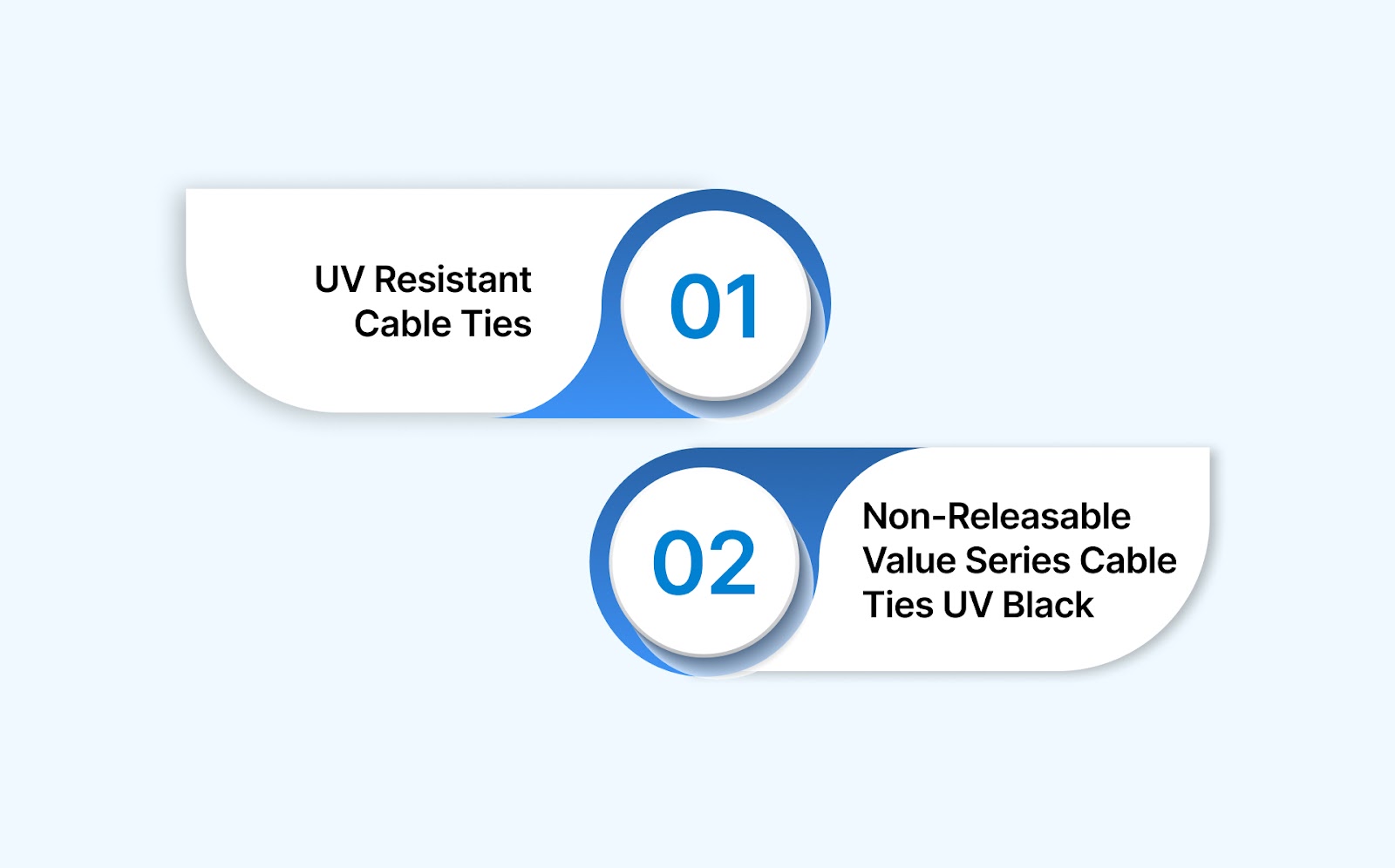
Selecting the right cable tie for solar installations is crucial for long-lasting cable management. The appropriate tie ensures that your solar system remains organized, secure, and resilient to various weather conditions and temperature fluctuations.
Below are some of the most effective types of cable ties designed to secure cables in solar setups:
- UV Resistant Cable Ties: UV Resistant Cable Ties are ideal for cable bunching in outdoor weather conditions. These ties come with a self-locking, non-releasable, economical & versatile method of cable/wire bunching systems.
- Material: Nylon 6.6
- Temperature Resistance: -40°C to 85°C
- Non-Releasable Value Series Cable Ties UV Black: These UV-resistant black ties combine the durability of value series ties with additional protection from the outdoor climatic conditions, ensuring longer-lasting performance.
- Material: Nylon 66
- Temperature Resistance: -40°C to +85°C
Stainless Steel Ties
Stainless steel ties offer superior strength and reliability for cable management in more demanding solar installations. These ties are ideal for high-stress environments, offering enhanced durability and corrosion resistance. Here are the top types of SS ties you can consider:
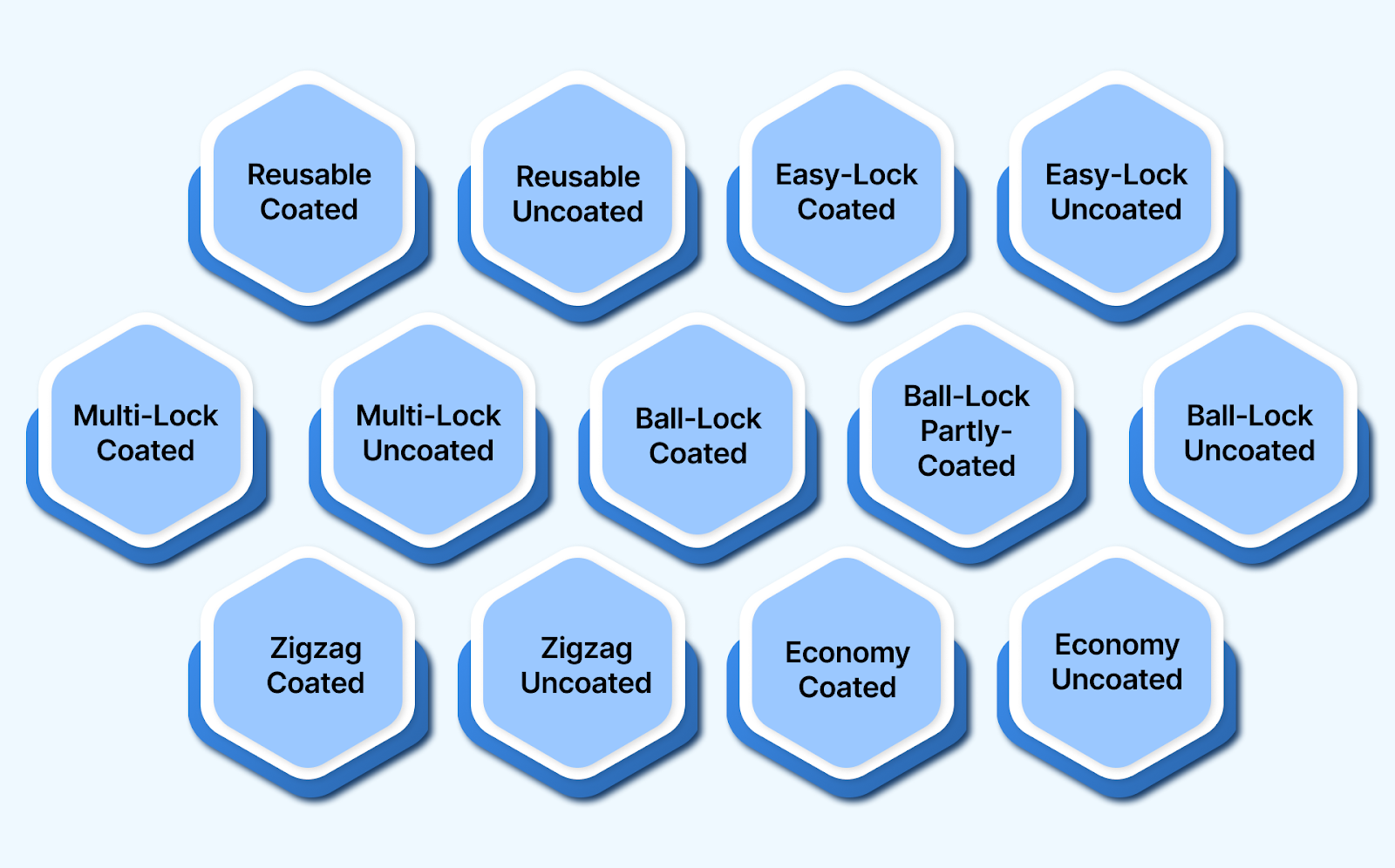
- Reusable Steel Tie Coated: These reusable steel ties are perfect for fastening cables, tubes, and pipes. They can be reused. They are built to withstand corrosive climates and high temperatures and provide high tensile strength, all while being resistant to smoke, UV, and corrosion.
- Material: Stainless Steel SS 316, SS 304
- Temperature Resistance: -80°C to +150°C
- Reusable Steel Tie Uncoated: This Reusable Steel Tie Uncoated offers a secure and safe fastening solution for cables and pipes. Designed for challenging corrosive and high-temperature environments, it uniquely features reusability and smooth edges for efficient installation.
- Material: Stainless Steel SS 316, SS 304
- Temperature Resistance: -80°C to +538°C
- Easy Lock Steel Tie Coated: This Easy Lock Steel Tie Coated is specifically designed for strong and secure fastening in corrosive and high-temperature environments. It features a self-locking system for fast installation and a durable, non-toxic coating that ensures long-term performance even in demanding conditions.
- Material: Stainless Steel SS 316, SS 304
- Temperature Resistance: -80°C to +150°C
- Easy Lock Steel Tie Uncoated: This Easy Lock Steel Tie Uncoated provides a robust and secure fastening solution. Designed for corrosive climates and high-temperature conditions, it features a self-locking system for fast, strong installation and smooth edges for enhanced safety.
- Material: Stainless Steel SS 316, SS 304
- Temperature Resistance: -80°C to +538°C
- Multi-Lock Steel Tie Coated: This Multi-Lock Steel Tie Coated offers an exceptionally strong and secure fastening solution, ideal for corrosive and high-temperature environments. Its multi-locking system allows for stronghold and accommodates double wraps, while the durable, non-toxic coating ensures long-term performance and UV resistance.
- Material: Stainless Steel SS 316, SS 304
- Temperature Resistance: -80°C to +150°C
- Multi-Lock Steel Tie Uncoated: This Multi-Lock Steel Tie Uncoated provides a highly secure fastening solution, particularly suited for corrosive and high-temperature conditions. It features multiple self-locking systems designed for a stronghold, accommodates double wraps for added security, and has smooth edges for safe installation.
- Material: Stainless Steel SS 316, SS 304
- Temperature Resistance: -80°C to +538°C
- Ball Lock Steel Tie Coated: This Ball Lock Steel Tie Coated is designed for fast, easy, and self-locking installation and is suitable for corrosive climates and high-temperature environments. Its non-toxic, UV-resistant coating ensures long-term life, and the internal ball provides positive locking when bundled.
- Material: Stainless Steel SS 316, SS 304
- Temperature Resistance: -80°C to +150°C
- Ball Lock Steel Tie Partly Coated: This Ball Lock Steel Tie Partly Coated is designed for fast, easy, and self-locking installation in corrosive and high-temperature environments. It provides positive locking when bundled via an internal ball, and its non-toxic, UV-resistant coating ensures long-term durability in such climates.
- Material: Stainless Steel SS 316, SS 304
- Temperature Resistance: -80°C to +150°C
- Ball Lock Steel Tie Uncoated: This Ball Lock Steel Tie Uncoated offers fast, easy, and self-locking installation. It is suitable for corrosive climates and high-temperature conditions. Its design provides positive locking via an internal ball when bundled and features smooth edges for safe handling during installation.
- Material: Stainless Steel SS 316, SS 304
- Temperature Resistance: -80°C to +538°C
- Ball Lock Zigzag Tie Coated: This Ball Lock Zigzag Tie Coated is designed for applications requiring extensive vibration where positive locking is essential. It features modified waveform clamps that maintain tension and a non-toxic, UV-resistant coating for long-term durability in corrosive climates.
- Material: Stainless Steel SS 316, SS 304
- Temperature Resistance: -80°C to +150°C
- Ball Lock Zigzag Tie Uncoated: This Ball Lock Zigzag Tie Uncoated is designed for applications with extensive vibration where positive locking is critical. Its modified waveform clamps effectively retain tension, providing a solid grip even with low applied forces. It features smooth edges for safe installation.
- Material: Stainless Steel SS 316, SS 304
- Temperature Resistance: -80°C to +538°C
- Reusable Economy Steel Tie Coated: This Reusable Economy Steel Tie Coated is suitable for corrosive and high-temperature environments and designed for low-cost and low-tensile applications. It features smooth edges for safe installation and a non-toxic, UV-resistant coating for long-term durability in harsh climates.
- Material: Stainless Steel SS 316, SS 304
- Temperature Resistance: -80°C to +150°C
- Reusable Economy Steel Tie Uncoated: This Reusable Economy Steel Tie Uncoated is suitable for corrosive and high-temperature environments. It is specifically designed for low-cost and low-tensile applications. It features smooth edges to ensure utmost safety during installation.
- Material: Stainless Steel SS 316, SS 304
- Temperature Resistance: -80°C to +538°C
Surelock provides all these types of cable ties and more. Offering superior strength and durability, it ensures that your solar installation remains securely fastened, even in the harshest conditions. From UV-resistant to steel options, find the perfect solution for all your needs.
Now that we know what types of ties are available, let’s take a closer look at how these ties are applied in real solar projects.
Key Applications and Uses of Cable Ties in Solar Projects
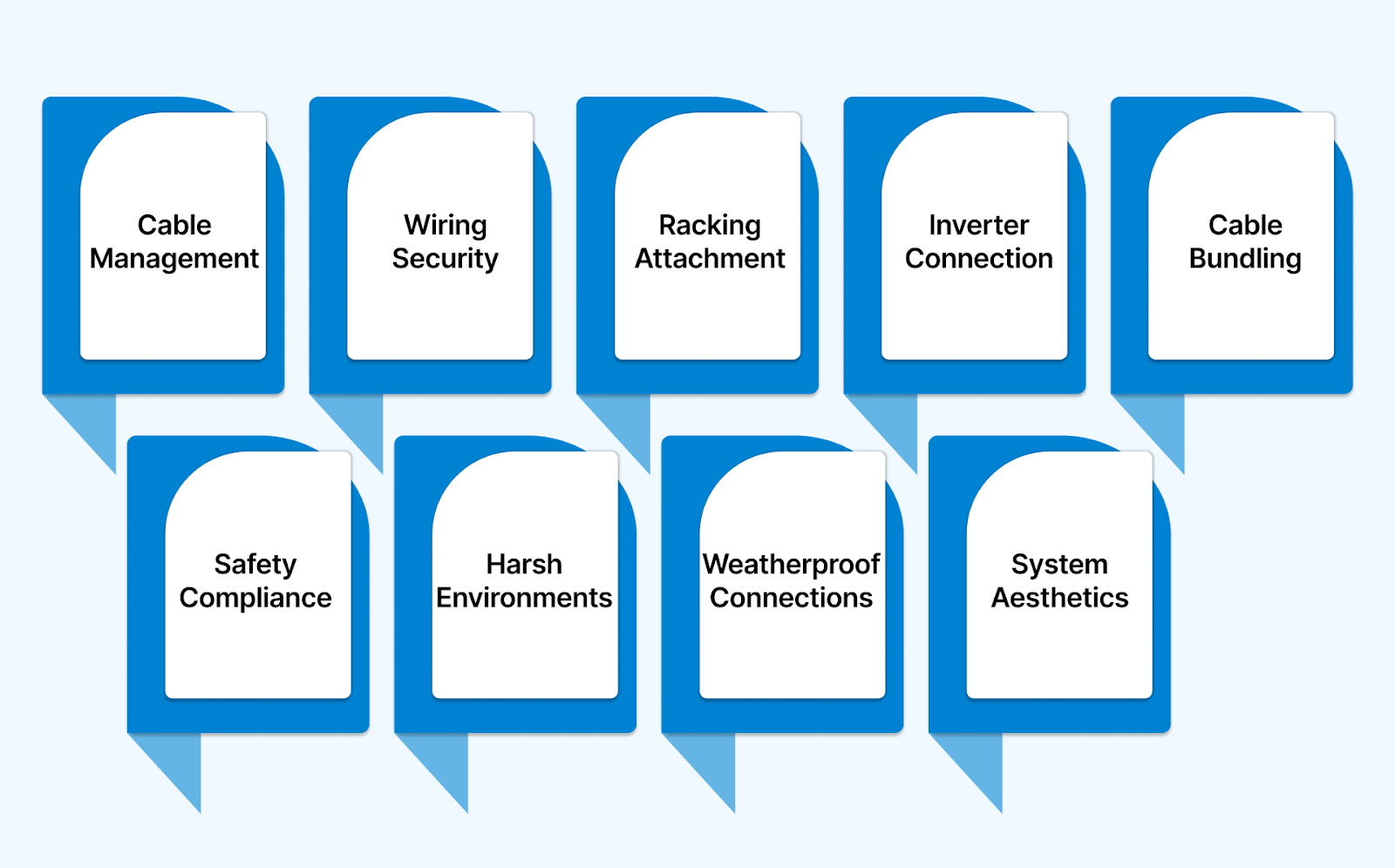
Cable ties are essential for maintaining solar power systems' safety, efficiency, and longevity. They offer a simple yet effective solution for organizing and securing cables, ensuring that each component operates seamlessly within the system.
Below are key applications and uses of cable ties in solar projects:
- Cable Management: Cable ties are crucial in organizing and securing the numerous cables within a solar installation. They ensure that cables are neatly bundled, preventing them from becoming tangled or exposed to environmental hazards. This organization helps reduce the risk of damage and ensures the system's optimal performance.
- Securing Solar Panel Wiring: In solar arrays, cable ties fasten the wiring connecting individual solar panels. They keep the cables neatly arranged, preventing them from sagging or rubbing against surfaces that could cause wear or damage over time.
- Mounting Cables on Racking Systems: Solar panel racking systems require secure routing of cables. Cable ties fasten cables to the racking structure, keeping them in place and protecting them from shifting during installation or over time, especially in windy conditions.
- Connection to Inverters and Controllers: Inverters and charge controllers are key components of solar power systems. Cable ties ensure the cables connecting these components are organized and securely attached, minimizing the risk of loose wires, which could cause electrical failures or safety hazards.
- Bundling Cables for Conduit Systems: In large-scale solar installations, cable ties are used to bundle multiple cables into a single conduit. This organization simplifies the installation process and reduces the risk of cable wear and tear caused by friction or external elements.
- Ensuring Safety and Compliance: Proper cable management using cable ties ensures compliance with safety standards, as it prevents cables from being exposed to mechanical stress or environmental damage. It also makes it easier for maintenance crews to inspect and repair the system when needed.
- Resilient Solutions for Harsh Environments: For solar power systems located in harsh environments, such as coastal or desert areas, high-performance cable ties with UV protection, heat resistance, and corrosion resistance are crucial. These ties prevent premature failure, ensuring the system remains operational for years.
- Weatherproofing Cable Connections: Cable ties also protect cable connections from the elements. When exposed to rain, wind, or direct sunlight, properly secured cables are less likely to suffer damage, leading to fewer repairs and lower maintenance costs.
- Improving Aesthetic and System Integrity: A well-organized cable system improves the performance of the solar installation and enhances its visual appeal. Tidy, neatly arranged cables reduce clutter and ensure the system functions without interference, contributing to a more efficient setup.
While cable ties are essential for solar projects, stainless steel ties, in particular, offer unmatched durability. Let's explore when stainless steel ties are the best choice for solar installations.
When to Choose Stainless Steel Ties for Solar Installations
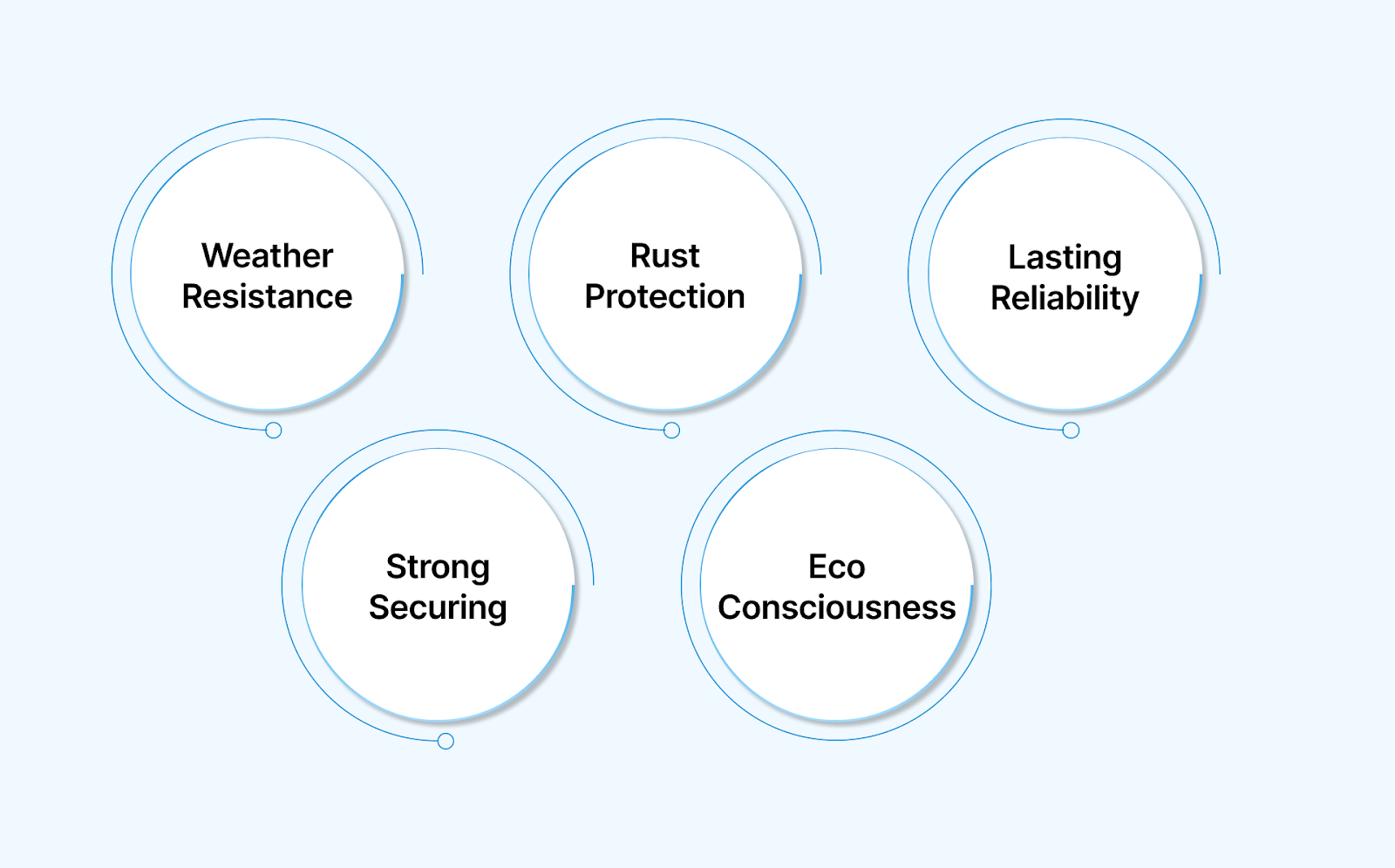
The decision to use stainless steel ties should be based on several key considerations to ensure optimal performance, reliability, and safety. Here are the primary factors to guide your decision:
- Exposure to Harsh Weather Conditions: Stainless steel ties are ideal when the installation is exposed to extreme weather conditions such as high winds, intense sunlight, or heavy rain. Their resistance to UV rays, moisture, and temperature fluctuations ensures that the ties remain intact and secure over time.
- Corrosion Resistance Requirements: Stainless steel ties are a must for solar installations in coastal or industrial areas with high humidity or salt exposure. Their exceptional corrosion resistance ensures that they won’t deteriorate, even in the harshest environments, protecting the cables and preventing system failure.
- Long-Term Durability and Low Maintenance: Stainless steel ties are designed for long-term durability and require less frequent maintenance or replacement. When planning solar systems that need to perform consistently over many years, these ties offer a cost-effective solution by reducing the need for repairs and replacements.
- Heavy-Duty Cable Bundling: When dealing with large cable bundles or high-stress installations, stainless steel ties provide superior strength and support. They can handle the weight and mechanical stress without snapping or losing effectiveness, making them ideal for securing power cables and high-voltage connections.
- Sustainability and Environmental Impact: Stainless steel ties are 100% recyclable, making them an environmentally friendly option for solar installations. Using stainless steel ties supports the renewable energy industry’s focus on sustainability, contributing to a greener, more eco-conscious project.
To get the most out of your cable ties, it's important to follow best installation practices. Let’s walk through the steps that ensure optimal performance and longevity of your solar cable management.
Best Practices for Installing Cable Ties in Solar Installations
Proper installation of cable ties is essential for ensuring the long-term performance, safety, and reliability of solar systems. Adhering to best practices during installation protects the system from potential damage, optimizes efficiency, and reduces the risk of maintenance issues.
Here are the key best practices to follow when installing cable ties in solar projects:
- Choose the Right Type of Cable Tie: Select the most suitable cable tie material (e.g., stainless steel or UV-resistant nylon) based on environmental conditions such as temperature, exposure to UV light, and humidity.
- Avoid Overtightening: While securing cables, ensure that cable ties are tight enough to hold them in place but not so tight that they strain the wires. Overtightening can lead to wire damage or tie breakage, compromising system performance.
- Maintain Proper Cable Spacing: Ensure that cables are properly spaced and organized to avoid overlapping or bunching. Over-bundling cables can cause hotspots, restrict airflow, and increase the risk of overheating, leading to system inefficiencies or failures.
- Route Cables Securely: When routing cables, avoid sharp bends, edges, or areas where cables could rub against other surfaces. Use cable clips or ties to secure cables along straight paths and protect them from mechanical stress.
- Ensure Cable Movement Flexibility: Allow enough slack in cables to accommodate any movement caused by temperature changes or mechanical shifts. Ties should not restrict the natural expansion and contraction of cables due to thermal cycles.
- Proper Placement of Cable Ties: Place cable ties at intervals that provide optimal support while avoiding unnecessary tension. Typically, ties should be placed at regular intervals along the cable run, ensuring even distribution of mechanical stress.
- Cut Excess Tie Lengths Neatly: After securing the cables, trim any excess tie lengths cleanly with flush cutters. Leaving jagged edges can lead to injury or damage to cables during future maintenance work.
- Label Cables for Easy Identification: In complex installations, consider using cable ties with identification tags or labels. This makes tracking and troubleshooting cables during maintenance or system upgrades easier.
- Inspect and Maintain Regularly: Schedule periodic inspections to ensure the cable ties are secure, undamaged, and hold the cables in their intended position. Replace any broken or degraded ties promptly to prevent damage to the wiring system.
At Surelock, we provide high-quality cable ties, clips, clamps, and wiring accessories. All are made from durable materials and are versatile for various applications. Explore our selection today to find the perfect fit for your projects.
In addition to installation, selecting the right cable tie for your specific solar setup is key. Let’s consider the key factors when making this important decision.
How to Select the Right Cable Ties for Your Solar Installations
Selecting the right cable ties for your solar installation is crucial to ensuring long-lasting performance, efficiency, and safety. The right cable ties can withstand environmental stress, UV exposure, and high temperatures, providing optimal support for your solar system components.
Here are the key considerations for choosing the best cable ties for your solar projects:

- Consider the Environmental Conditions: Choose cable ties that can handle the specific environmental factors in your area. For outdoor solar installations, UV-resistant cable ties are useful to prevent degradation from prolonged sun exposure. Stainless steel ties are ideal for harsh environments like coastal regions, where saltwater exposure is a concern.
- Material Selection for Durability: The material of the cable tie determines its strength and resistance. For installations exposed to high heat or corrosive elements, stainless steel ties offer superior durability.
- Temperature Resistance: Ensure the cable ties you select are rated for the temperatures your installation will endure. Stainless steel cable ties are designed to withstand high temperatures, making them perfect for areas with high sun exposure, such as rooftops or solar farms.
- Choose the Right Size and Length: Select cable ties with the appropriate width and length for your cable management needs. Ties that are too short will not effectively secure the cables, while too long ties may cause excessive strain on the cables. Be sure to choose a size that comfortably secures the cable without compromising its integrity.
- Evaluate Load Capacity: Different types of cable ties have varying load capacities. Be sure to select ties that can handle the weight and mechanical stress of the cables they will secure.
- Check for Reusability: If the installation requires frequent adjustments or disconnections, consider reusable cable ties. These ties allow for easy removal and reinstallation without compromising their integrity.
- Look for Certification and Standards Compliance: Ensure that the cable ties meet industry standards and certifications for solar applications. For example, ISO 9001:2015 (International Organization for Standardization 9001:2015) certifications ensure that the cable ties have passed rigorous quality tests and comply with safety standards.
By considering these factors, you can select the most suitable cable ties for your solar installation, ensuring secure and efficient cable management that will last.
Conclusion
Choosing the right cable ties in outdoor solar installations is crucial for ensuring durability, safety, and long-term performance. From UV resistance to tag ties, these ties help maintain the efficiency of your system, regardless of weather conditions.
For your next solar project, trust Surelock’s range of high-quality cable ties, including UV-resistant and stainless steel options, specifically designed to withstand the toughest environments. Your solar system stays secure, efficient, and long-lasting with our cable ties.
Contact us today and secure your solar setup for the future



